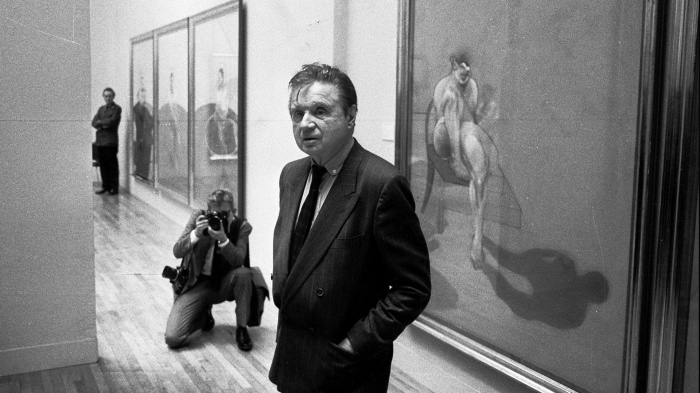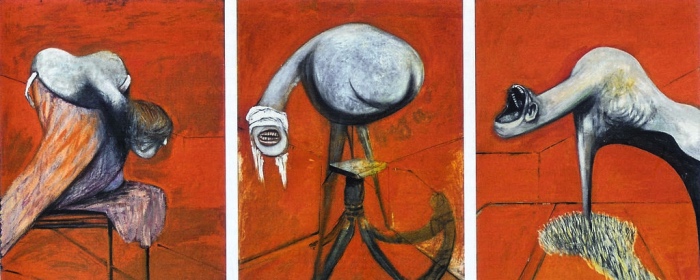
Artist Francis Bacon in front of the left panel of his ‘Triptych’ (1983) at his Tate Gallery show, 1985. (Photo by Michael Ward/Getty Images). Image source: http://floodmagazine.com
5 THINGS TO KNOW ABOUT FRANCIS BACON
Francis Bacon was an artist who broke the rules, hungry for life and passion, but he was also so immersed in the slime of emotions that he was almost overwhelmed by them.
He represented sorrow, anguish and a cruel world view.
Treviso will host an exhibition dedicated to Francis Bacon which it will certainly cause debate, because it happens every time with this artist and his works.
Bacon is a thorny artist, who flings his life made up of excess in your face, and obligates you to reflect upon your life.
As he was a damned artist, Bacon lived hard, and life put him to the test several times, but it also gave him the gift of portraying a complicated century, the 20th century, of which he was the mirror of its dark side.
5 things to know about Francis Bacon.
1.
Francis Bacon was born in Dublin on October 28th 1909 to a rich family that boasted among its ancestors the famous philosopher Francis Bacon.
Bacon’s relationship with his father, a British Army captain, was always troubled and stormy.
He was in poor health, and for this reason his father considered him to be not too virile. But above all, the artist was aware of his homosexuality since he was a boy, and he didn’t hesitate to come out to his father, who turned him out of the house.

Photograph by Carlos Freire: Francis Bacon in his studio, 7 Reece Mews, London. Image source: www.mbartfoundation.com
2.
At the age of 16 Francis Bacon moved to London, rejected by his family, and he had no idea of what he wanted to become in life.
Those were fundamental years for his artistic training, because Bacon began painting and visiting exhibitions, and art galleries. During that period he was deeply influenced by Picasso.
3.
Francis Bacon began working as an interior designer, drawing furniture in Deco style.
At the same time he began painting, and in 1933 he exhibited his works for the first time, whereas the following year he arranged his first one-man exhibition.
1944 was the fundamental year for Bacon, because he exhibited “Three Studies for Figures at the Base of a Crucifixion”, which caused violent reactions, and paved the way to success.

Francis Bacon, Tre Studi per figure alla base di una Crocifissione, 1944, Londra. Image source: nico7martin via Flickr
4.
After 1944 Bacon’s life was studded with success and excess.
He became a point of reference for new generations of artists, and he angered those who considered him to be a bad artist and a person whose life was characterised by alcohol, gambling and several lovers.
Between 1949 and 1956 Bacon painted his masterpiece “Study after Velázquez’s Portrait of Pope Innocent X” (1953), a remake of the famous painting housed at the Doria Pamphiliji Gallery.
Bacon transfigured Pope’s face, and the painting became a symbol of the existential angst of the society of the 20th
5.
Francis Bacon died suddenly in Madrid in 1992, and his studio in London would be acquired by the Dublin City Gallery.
The analysis his life and his works, made up of memories and tokens of the numerous relationships he established throughout his life, began.
Thus, the contradictions of a man, conscious that he left his mark in the world, and who hasn’t been appreciated all the way yet, emerged.

Francis Bacon, Portrait of Pope Innocent X. Image source: http://leboisdesarts.altervista.org


He dies in 1992, not 1922!
Thank you Jay. We have corrected the typing error 😉